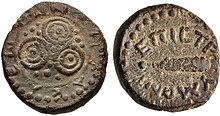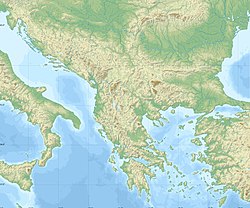Heraclea Sintica
Ancient Greek: Ἡράκλεια Σιντική | |
 | |
| Alternative name | Heraclea Strymonike |
|---|---|
| Location | Blagoevgrad Province, Bulgaria |
| Coordinates | 41°27′01″N 23°15′52″E / 41.4502434992°N 23.264466914°E |
| Type | Settlement |
| Part of | Macedonia, Ancient Rome |
| History | |
| Founded | 356–339 BC |
| Abandoned | c. 500 AD |
| Cultures | Macedonian, Greco-Roman |
| Site notes | |
| Condition | Ruined |
| Public access | Yes |
| Website | https://petrichhistorymuseum.bg/ (in Bulgarian) |
Heraclea Sintica (
History
Heraclea Sintica was founded sometime between 356 and 339 BC by Philip II of Macedon with Macedonian settlers from Heraclea in Mygdonia.[1] This settlement may have replaced a previous Thracian tribal center called Sintia as the Roman historian Livy emphasized that Heraclea lay within the territories of the Sintoi. These people were evidently chased away at the city's foundation, however, as Appian included the Sintoi with the Dardanians and Enetoi as tribes outside the province of Macedonia. Moreover, there is a conspicuous absence of Thracian names among inscriptions from Heraclea which also suggests that the Sintoi had been driven out of the Styrmon Valley and that they did not intermix with the colonizers.[2]
The general Asclepiodotus of Heraclea was a native. Demetrius, son of Philip V of Macedon, was slain at Heraclea Sintica.[3] Coins minted here in antiquity have survived.[4]
A powerful earthquake around 425 AD destroyed the majority of the city's infrastructure, including the civic basilica, and also caused the nearby Strumeshnitsa River to flood the forum. After 457 AD, groups of people returned to live in the ruins, but life in Herclea gradually dissipated with no indications of permanent habitation by 500 AD.[5]
The polis was identified by Assoc. Prof.
Since 2007 archaeological excavations have been taking place at Heraclea Sintica, led by Assoc. Prof.
See also
References
Citations
- ISSN 2367-5640.
- ^ Vagalinski. 2015, pp. 48–49.
- Ab urbe condita Libri[History of Rome]. Vol. 40.24.
- ^
 Smith, William, ed. (1854–1857). "Heraclea Sintica". Dictionary of Greek and Roman Geography. London: John Murray.
Smith, William, ed. (1854–1857). "Heraclea Sintica". Dictionary of Greek and Roman Geography. London: John Murray.
- ISBN 978-86-6439-054-5.
Bibliography
- Claude Lepelley: Une inscription ďHeraclea Sintica (Macédoine) récemment découverte, révélant un rescrit de ľempereur Galère restituant ses droits à la cite. in: Zeitschrift für Papyrologie und Epigraphik, 146 (2004), 221–231.
- Georgi Mitrev: Civitas Heracleotarum. Heracleia Sintica or the Ancient City at the Village of Rupite (Bulgaria). in: Zeitschrift für Papyrologie und Epigraphik, 145 (2003), 263–272.
- Georgi Mitrev: On Skotoussa and „Scotusaei liberi” from the valley of the Strymon River. in: Arheologia Bulgarica, XII (2008), 2, 47–58.
- Konrat Ziegler und Walter Sontheimer (Hrsg.): Der Kleine Pauly Bd. 2 (1975), Sp. 1034–1035.
- Emil Nankov: “In Search of a Founder and the Early Years of Heraclea Sintica,” In: Vagalinski, L. and Nankov, E. (eds.) Heraclea Sintica: from Hellenistic polis to Roman civitas (4th c. BC-6th c. AD), Proceedings from a conference at Petrich, September 19–21, 2013, Papers of the American Research Center in Sofia, vol. 2, 7–35.


